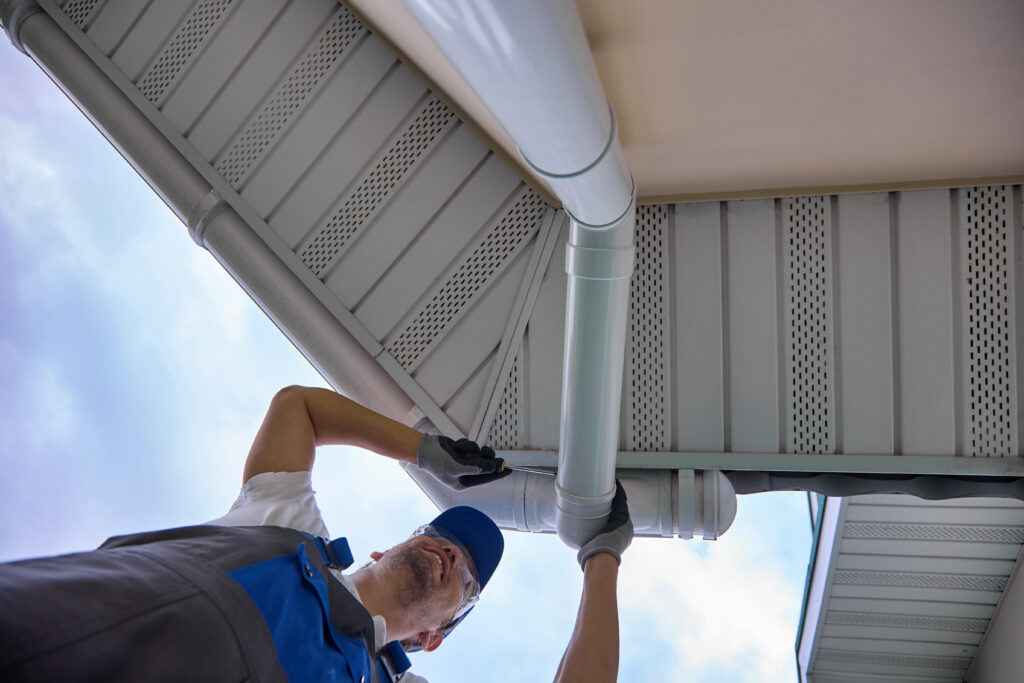Overflowing gutters can lead to significant damage to your home. When gutters overflow, they fail to divert water away from your home, potentially leading to water infiltration in your basement and damage to your foundation.
This overflowing disrupts the immediate function of the gutters and often leads to wood rot, an issue that can significantly weaken the structural components of your home.
Hence, fixing your overflowing gutters in time is essential to maintain the structural integrity of your home and to avoid costly repairs in the future.

Step 1: Choose The Right Time
Spring and fall are best for fixing gutters due to several factors. These periods typically offer more moderate and predictable weather conditions, making it safer and more comfortable to work outdoors.
Additionally, these seasons align with natural patterns of tree shedding. In the fall, leaves and twigs fall heavily, often clogging gutters. In the spring, blossoms, seeds, and other debris can accumulate similarly.
By scheduling gutter maintenance during these seasons, homeowners can preemptively clear out the natural debris that accumulates during these times, ensuring that gutters remain functional throughout the year.
Step 2: Ensure Safety
Gutter maintenance can be risky without the proper precautions. Safety begins with a sturdy ladder that provides stable support. It’s important to ensure the ladder is on level ground and firmly positioned.
Using non-slip shoes is critical to prevent slips and falls, especially when working at heights. Gloves are essential not just for grip but also to protect your hands from sharp edges and debris within the gutters. Safety goggles can also be worn to protect your eyes from flying debris.
It’s recommended to have someone assist you by steadying the ladder and passing tools as needed. Remember, no repair is worth risking personal injury; if the task seems too challenging, consider hiring a professional.
Step 3: Inspect The Gutters
A meticulous inspection is necessary in gutter maintenance. Begin this process by methodically examining the gutters along their entire length, looking out for any signs of wear and tear, such as cracks, holes, or areas of rust that could compromise their integrity.
Special attention should be given to regions where the gutters appear to be sagging or detaching from the house, as these are indicative of failing support hardware or deeper structural issues. Equally important is the inspection of gutter seams and joints; separation or leakages here can be subtle yet detrimental.
Identifying these problems is not just about preventing overflow; it’s about averting more extensive damages caused by improper water diversion, which can compromise your home’s foundation and exterior.
Step 4: Clean The Gutters
Begin by manually extracting any large debris using a hand rake or a similar tool. For a more comprehensive clean, employ a gutter scoop, which is ergonomically designed to align with the gutter’s shape, facilitating the removal of smaller particles that can accumulate and cause blockages.
Focus not only on the gutter length but also on the downspouts. It’s common for downspouts to become major culprits in gutter overflow due to blockages, hindering water flow and causing backups.
In instances where debris is stubborn or compacted, a plumber’s snake tool can be invaluable in dislodging and clearing these obstructions, ensuring a clear path for water flow.
Step 5: Check For Leaks
Post-cleaning, the next critical step is to assess the gutters for any leaks. This is best achieved by simulating rainfall conditions: run water through the gutters using a hose and observe.
Pay attention to the water’s journey through the gutter and into the downspout, watching out for any unexpected drips or leaks.
Minor imperfections like small holes or cracks can usually be rectified with a specialized, waterproof gutter sealant.
This step is vital for maintaining the gutter’s integrity, as overlooked leaks—no matter how minor—can escalate into significant water damage over time, potentially affecting your home’s structural health.
Step 6: Ensure Proper Slope
Maintaining an appropriate gutter slope is essential for effective water drainage. A subtle but significant slope, approximately a quarter-inch decline for every 10 feet of gutter, should be maintained.
This gradient ensures that water is directed towards the downspouts efficiently, preventing stagnant water pools.
Should you observe water stagnation or improper flow, gutter hanger adjustments might be necessary, as incorrect sloping can lead to water accumulation, overflow, and consequential water damage to the home’s foundation and exterior.
Step 7: Install Gutter Guards
The installation of gutter guards is highly recommended to mitigate the accumulation of debris and reduce the frequency of gutter cleaning. These devices, designed to cover the opening of the gutters, effectively block the ingress of leaves and large debris while permitting water to filter through.
Various types of gutter guards are available, including mesh screens, foam inserts, and brush-style guards, each offering different benefits and installation methods.
The incorporation of gutter guards into your gutter system can drastically decrease the volume of debris accumulation, thereby making gutter maintenance a less frequent and laborious task and prolonging the lifespan of your gutters.
Conclusion
Effectively fixing an overflowing gutter involves thorough inspection, regular cleaning, and proactive maintenance measures like installing gutter guards.
These steps are vital in preventing water damage, safeguarding the home’s foundation, and ensuring the longevity of the gutter system.
By diligently following this guide, homeowners can maintain their gutters in optimal condition, protecting their homes against the hazards of water overflow and related damages.






